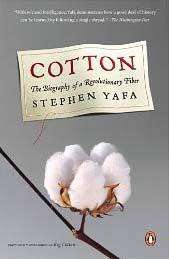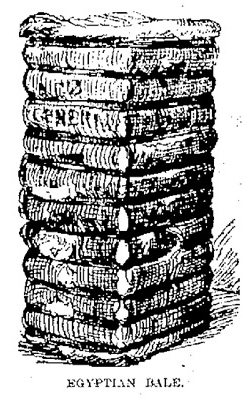News & Tall Tales. 1800s.

Cotton
Excerpted from The Galveston Daily News, June 15, 1895, Galveston, Texas
THE AMERICAN BALE.
It is the Laughing Stock at Cotton Ports and Manufacturing Centers.
EVIDENT AND URGENT NEED
To Avoid Telling Disadvantage When American-Baled Cotton Comes in Contact and Competition with Foreign Cotton.
The information given in consular reports relating to bailing of cotton excited strong interest in the cotton trade of the United States, and the department was requested to obtain fuller and more specific charts upon the subject.
Accordingly, consular officers were instructed to prepare reports giving dimensions and weights of American, Egyptian, Indian and South American cotton bales received at their ports, describing the covering of bales, the character of material, both as to wrapping and bands, and the condition in which the cotton is usually received: stating whether American cotton suffers directly or indirectly by comparison with foreign cotton on account of either the style or manner of covering, or the quality or extent of the compressing; describing compress machinery and covering for cotton bales used, cost of compressing, etc., at cotton-exporting points, etc.
The reports received by the department in answer to the circular cover sixty pages of the consult reports. The reply from Trieste, giving the comparative dimensions and weights of the bales of American, Indian, Egyptian and Turkish cotton are shown by the following table. The American bale is not of uniform length or size.
| Description | Length: inches | Width: inches | Thick: inches |
Avg. Wt. Lbs. |
|---|---|---|---|---|
| American | 60-71 | 32-35 | 19-22 | 500 |
| Indian | 48 | 22 | 17 | 410 |
| Egyptian | 50 | 30 | 20 | 740 |
| Turkish | 38 | 34 | 34 | 400 |
All cotton from America, India, Egypt and Turkey has a casing manufactured from jute, but the coverings of the bales differ materially as to texture and degree of protection afforded to the cotton. The American cotton bagging is made of the large, course strands of jute, with interstices between the strands, which are considerably increased by the expansive power of the compressed cotton.

The covering on the Indian, Egyptian and Turkish bales is of bagging made of smaller strands of jute, and more compactly woven, and while it does not seem to be as strong as the American, it comes in better shape and more effectively protects the cotton.
The bands, or ties, on all of the bales are of iron, and those on the foreign cotton do not vary materially in width and thickness from those of American use. The bales from India and Egypt have more bands than the American, the Indian having from eleven to thirteen, being a band to every 4 or 4-1/2 inches, and the Egyptian ten to eleven, making one band to every 4-1/2 to 5 inches. The cotton bales from Turkey generally have four bands. The bands on the Egyptian bales have a different fastening from those on American bales, the American being what is known as the arrow-tie buckle. The Egyptian bands have two square-sided oblong holes at each end, and an easily adjustable metal button, or buckle fastening, as is shown by the drawing. The band on the Indian cotton is wound around the bale, being in some cases only one continuous hoop; in other cases the band is composed of two, or perhaps three parts. They have no fastenings, but are held in place by the ends being overlapped by the band.
The American cotton comes in worse condition than any of the various sorts received, both as regards bands and covering material and exterior condition of the contents. The interior of the cotton is not injured, its compressed condition resisting the penetration of rain and water, except in cases where many bands are off. The jute casing is torn, and the cotton exposed to mud, water, rain, theft and fire. The bands easily come off one, two and sometimes more being frequently loose or broken; the cotton bulges out and more easily absorbs water, takes up dirt and loses on every handling. The Indian and Egyptian cotton, on the other hand, usually comes in good condition neat and trim. The bales are cased in a clean, compact covering, leaving little or none of the cotton exposed, and are firmly bound with bands, which are rarely out of place.

After careful investigation, the consuls are satisfied American cotton suffers in comparison with foreign cotton, both on account of the style or manner of covering and the extent of compressing. Dealers in cotton complain of the condition in which American cotton reaches the market and the difficulty they experience in handling it. The covering is torn, frequently hoops are off, the cotton exposed and liable to loss from mud, dust, theft and handling. It is almost impossible to decipher the marks on the bales, and great confusion and trouble arise therefrom . . . On the other hand, the Indian and Egyptian cotton comes well and closely covered and wrapped snug and tight. The bales are clearly marked on the sides and both ends, are easily identified, and the mixing of bales without marks very seldom occurs. The bales are of uniform size, and are more compressed than the American, and thus expense is saved in ocean freight, storage and freight in the transport wagons to the interior. The American bales vary in size, which also adds to the expense . . . Buyers in the interior know exactly, in ordering Indian cotton by the wagon load, how much they will receive; one wagon holding five-five bales. One wagon holds twenty-five to twenty-eight American bales. This, at the comparative weight of 410 pounds for Indian and 500 pounds for American, gives a freight advantage of from 8,000 to 10,000 pounds per wagon-load in favor of Indian cotton. The same holds true as to ocean freight and to storage...
. . . Inquiries of dealers as to the most desirable of the methods employed are invariably answered in favor of the Indian, though they usually add that the Egyptian is practically as good.
 The high pressure to which Egyptian and Indian cottons are subject, all dealers affirm, has no evil effect upon the staple. On the contrary, it is advantageous in many ways. It is never yellow from exposure to daylight, and the excellent covering employed, which seldom tears, protects even the outer surface from contact with the dust and dirt on shipboard and at the landing places. An additional item, which may be of less importance, but to which attention is called by dealers here, is that these highly pressed bales are much liable to injury by exposure to rain, and it is stated that a cargo of Egyptian cotton recently sunk on a sailing vessel in the Mediterranean near Marseilles was raised after two weeks' exposure to the sea practically uninjured. The opinion held, without exception, by the merchants is that the ideal bale should weigh from 350 to 400 pounds, the latter figure preferred; that the cotton should by compressed into dimensions similar to the Indian, and that the bale should be hooped according to the latter system.
The high pressure to which Egyptian and Indian cottons are subject, all dealers affirm, has no evil effect upon the staple. On the contrary, it is advantageous in many ways. It is never yellow from exposure to daylight, and the excellent covering employed, which seldom tears, protects even the outer surface from contact with the dust and dirt on shipboard and at the landing places. An additional item, which may be of less importance, but to which attention is called by dealers here, is that these highly pressed bales are much liable to injury by exposure to rain, and it is stated that a cargo of Egyptian cotton recently sunk on a sailing vessel in the Mediterranean near Marseilles was raised after two weeks' exposure to the sea practically uninjured. The opinion held, without exception, by the merchants is that the ideal bale should weigh from 350 to 400 pounds, the latter figure preferred; that the cotton should by compressed into dimensions similar to the Indian, and that the bale should be hooped according to the latter system.
The average weight of the Texas cotton bales received at Bremen is 551 pounds, and the bales are about 5 feet long, 3 feet wide and 2 feet thick. The average weight of the New Orleans cotton bales is 490 pounds, and they are about 6 feet long, 3 feet wide and 1 foot 6 inches thick . . . The Brazilian cotton bales also differ in weight; they weight from 99 to 276 pounds. The average weight of the East Indian cotton bale is 386 pounds, and it is about 4 feet long, 1 foot 6 inches wide and 1 foot 7 inches thick. The best packing of American cotton is done in the gulf states Alabama, Mississippi and Louisiana. The cotton bales from these states arrive at Bremen in a far better condition that the upland cotton . . .
Cotton bales from Texas are generally furnished with seven iron bands of good material. The Texas cotton bales weight more than all other bales, although they are not as strongly pressed, owing to the dry character of the cotton, which does not permit as close compression as damp or moist cotton. The packing of cotton in Tennessee, Missouri and Arkansas is done in the same manner as in Texas. The wrappers are bands are of equal quality, but their weight is less than that of Texas bales. The bales are also furnished with seven iron bands, when pressed. The packing of cotton in Virginia, North Carolina, South Carolina and Georgia is very inferior. The bales are not of equal size are vary greatly in weight. The packing and wrapping are of inferior quality, and there is no uniformity in the parking of the bales . . .
Upland cotton is generally very compactly pressed, on account of the cotton being in a moist condition. From such pressing the staple suffers greatly. The cotton has a musty smell; it decays rapidly, and becomes much impaired if stored for any length of time . . .
It is high time that the shippers of cotton in the United States should take notice of the many complaints made for quite a number of years, and they they try their best to change a condition which is apt to ruin their trade, especially as they now have to deal with competitors from India and Egypt.
Cotton from Brazil is poorly packed in thin and tearable linen. Instead of iron bands, they use a kind of vegetable band of strong fiber. Their weight differs considerably, being loosely packed, almost without pressure.
The Austrian and German spinners are making efforts to secure better packing of American cotton. The Austrian Spinners' Union wrote to Director Stark asking that Germany be urged to cooperate. The Bremen Cotton Exchange (1872/1922), the spinners of Saxony, southern Germany, including Alsace-Lorraine, Baden and the Palatinate, and Bavaria have held meetings are are unanimously of the opinion that American cotton growers should be asked to pack as they were wont when jute was dear. I have on my desk practically all the important correspondence that passed between the unions on the subject . . .
New covering could be used for fifty purposes while the present has no value. The kind urged by manufacturers here as the very best to use could be cut up and sold for dishcloths and scouring rags. Besides, the south could make it, giving employment to labor and using up 150,000 to 200,000 bales of cotton annually in its manufacture. Of course, commerce must adjust its rates should this proposed packing be adopted . . .
It is not necessary to urge the importance of good packing. At every point, a gain is made. Customers are satisfied, losses of all kinds are minimized and freight and insurance rates are reduced. American cotton is preferred for general work, but with China entering the market (some of her cotton has come in here within a year), Egypt extending her cotton territory, and India already in the market, it will pay to give some heed to what manufacturers urge . . .
The replies to the department of state, covering all ports and manufacturing centers, bring out the fact that it is the rarest thing to receive bales from the United States intact; that there is not a cotton producing country that does not ship its crop in better shape; that it is easy to pick out the American bales from any pile of cotton by their torn and bedraggled appearance.

The Naval Order of the United States has a history dating from 1890. Membership includes a wide range of individuals, many with highly distinguished career paths.
The San Francisco Commandery meets the first Monday of each month at the San Francisco Italian Athletic Club in San Francisco, California and holds two formal dinners each year.

 Copyright ~ 1998-2018.
Copyright ~ 1998-2018. 